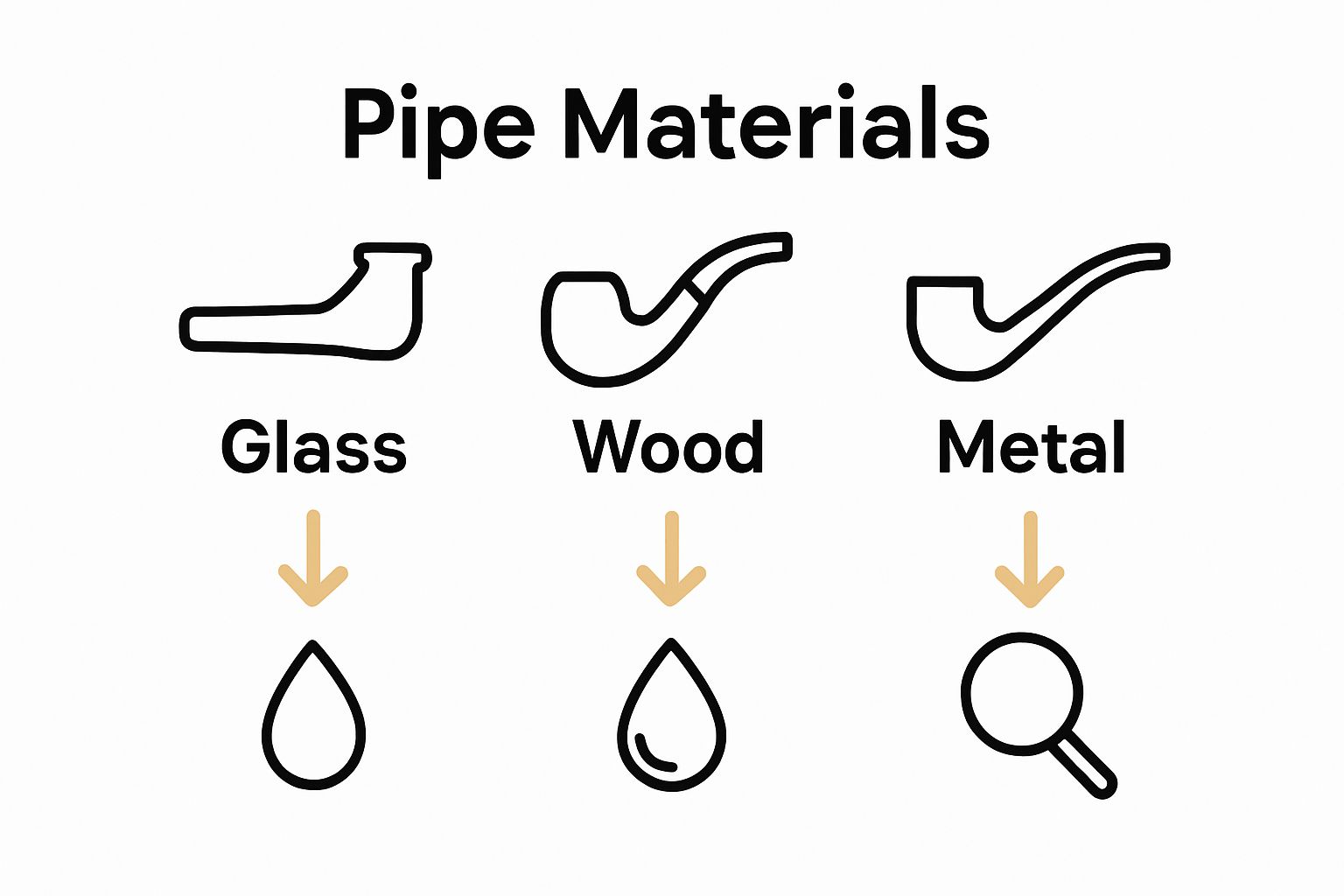Smoking pipes might look simple but they need a lot more attention than most people realize. Studies show that improper pipe maintenance can increase bacterial contamination by over 300 percent compared to regularly cleaned pipes. Most enthusiasts think a quick rinse keeps things safe and smooth. That’s where they get it wrong because true pipe care is a science and skipping it can ruin the flavor, the experience, and even the pipe itself.
Table of Contents
Quick Summary
| Takeaway | Explanation |
| Regular maintenance preserves smoking quality. | Consistent care prevents residue buildup, enhancing flavor and airflow for a better smoking experience. |
| Understand your pipe’s material needs. | Different materials like glass, wood, and metal require specific maintenance techniques for optimal performance. |
| Hygiene is critical for health. | Proper cleaning reduces bacterial growth, lowering health risks associated with unclean smoking devices. |
| Deep cleaning extends pipe lifespan. | Periodic deep cleaning and careful storage prevent degradation, allowing pipes to remain functional longer. |
| Monitor for performance impairment. | Recognizing signs like airflow restriction and temperature inconsistencies helps in timely maintenance to ensure quality smoking. |
What is Smoking Pipe Maintenance and Its Importance?
Smoking pipe maintenance represents a critical practice for enthusiasts who want to preserve the quality, performance, and longevity of their smoking accessories. This process goes beyond simple cleaning, encompassing a comprehensive approach to care that ensures optimal smoking experiences and protects your investment.
Understanding the Core Principles
At its essence, smoking pipe maintenance involves systematic care strategies that prevent resin buildup, minimize performance degradation, and extend the functional life of your pipes. Unlike casual cleaning, true maintenance requires understanding the intricate relationship between your pipe’s materials, usage patterns, and potential wear mechanisms.
Read our comprehensive guide on smoking pipe care reveals that proper maintenance directly impacts three critical aspects of your smoking experience:
-
Performance Preservation: Preventing residue accumulation that can alter smoke flavor and restrict airflow
-
Structural Integrity: Protecting delicate glass, ceramic, or metal components from gradual deterioration
-
Hygiene Management: Reducing bacterial growth and potential health risks associated with poorly maintained smoking devices
The Science Behind Pipe Degradation
Pipes undergo significant stress during regular use. According to scientific research from Materials Science journals, repeated heat exposure, chemical interactions, and mechanical stress contribute to microscopic structural changes. These transformations can compromise your pipe’s functional quality over time.
Effective maintenance disrupts this degradation cycle by implementing strategic cleaning protocols, carefully selected cleaning solutions, and proactive inspection techniques.
By understanding these scientific principles, smoking pipe enthusiasts can develop a nuanced approach that goes beyond surface-level cleaning, ensuring their cherished accessories remain in peak condition for years of enjoyment.
Why Proper Maintenance Matters for Smoking Experience
Proper smoking pipe maintenance transcends routine cleaning, representing a fundamental approach to preserving the quality, performance, and overall enjoyment of your smoking experience. Understanding the nuanced impact of maintenance helps enthusiasts make informed decisions about their smoking accessories.
Performance and Flavor Preservation
Maintenance directly influences the sensory aspects of smoking. Resin accumulation, mineral deposits, and residual buildup can dramatically alter the taste profile of your smoking materials. Learn more about smoking accessories reveals that consistent maintenance ensures a clean, pure smoking experience by preventing flavor contamination.
Key performance impacts include:
-
Airflow Optimization: Preventing blockages that restrict smooth smoke passage
-
Temperature Consistency: Maintaining even heat distribution for balanced combustion
-
Material Integrity: Protecting the pipe’s structural composition from degradation
Health and Hygiene Considerations
Beyond performance, maintenance plays a crucial role in user health. According to microbiology research from the Journal of Applied Microbiology, improperly maintained smoking devices can harbor significant bacterial colonies and potential pathogens.
Regular maintenance interrupts bacterial growth cycles, reduces potential health risks, and creates a more hygienic smoking environment. This proactive approach protects not just the smoking device, but also the user’s respiratory health and overall well-being.
How Smoking Pipes Work: Key Components Explained
Smoking pipes represent intricate devices engineered to deliver a controlled, enjoyable smoking experience through sophisticated design and precise mechanical principles. Understanding their fundamental structure helps enthusiasts appreciate the complexity behind these seemingly simple smoking accessories.
Fundamental Structural Components
Each smoking pipe comprises several critical elements working in harmonious interaction. Explore our professional smoking accessories guide highlights that these components are meticulously designed to optimize smoke filtration, cooling, and delivery.
Key structural elements include:
-
Bowl: The primary chamber where smoking material is placed and initially combusted
-
Stem: Responsible for channeling smoke from the bowl toward the mouthpiece
-
Shank: Connecting segment between bowl and stem that facilitates smooth smoke transition
Mechanical Principles of Smoke Transmission
According to engineering research from Tobacco Science Journal, smoking pipes operate through precise thermodynamic and fluid mechanics principles. The pipe’s design creates a controlled environment that manages several critical factors during smoke generation and transmission.
Smoke movement depends on multiple interconnected mechanical processes:
-
Airflow Dynamics: Creating negative pressure that draws smoke through the pipe
-
Heat Management: Dispersing combustion temperature to prevent material burning
-
Condensation Control: Minimizing moisture accumulation within pipe structures
The intricate engineering behind smoking pipes transforms a simple combustion process into a refined, controlled smoking experience by strategically managing temperature, airflow, and material interaction.
Common Issues and Their Impact on Pipe Function
Smoking pipes, despite their seemingly robust construction, are vulnerable to a range of performance-degrading issues that can significantly compromise their functionality and user experience. Understanding these potential problems enables enthusiasts to proactively protect their smoking accessories and maintain optimal performance.
Structural and Material Degradation
Explore our comprehensive smoking accessories guide reveals that material integrity plays a crucial role in maintaining pipe performance. Different materials react uniquely to repeated heat exposure, mechanical stress, and chemical interactions.
Key structural vulnerability factors include:
-
Thermal Stress: Repeated heating and cooling cycles causing microfractures
-
Chemical Erosion: Residue buildup altering material composition
-
Mechanical Wear: Gradual degradation from handling and usage
Performance Impairment Mechanisms
According to materials science research from Advanced Engineering Materials, smoking pipes experience complex degradation processes that progressively compromise their functional capabilities.
Critical performance impairment mechanisms encompass:
-
Airflow Restriction: Residue accumulation blocking smoke channels
-
Temperature Inconsistency: Uneven heat distribution affecting combustion quality
-
Flavor Contamination: Residual buildup altering smoke taste profile
By recognizing these potential issues, smoking pipe enthusiasts can implement strategic maintenance protocols that preserve their device’s performance, ensuring a consistently high-quality smoking experience.
This table summarizes the most common issues affecting smoking pipe performance and their specific impacts, as explained in the article, to aid in swift identification and troubleshooting.
| Issue | Description | Impact on Pipe Function |
| Airflow Restriction | Residue accumulation blocks smoke channels | Difficult or blocked draws |
| Temperature Inconsistency | Uneven heat distribution | Poor combustion, uneven burning |
| Flavor Contamination | Residual buildup alters smoke taste profile | Unpleasant or altered flavor |
| Thermal Stress | Repeated heating/cooling causes microfractures | Potential cracks, weakened structure |
| Chemical Erosion | Residue buildup alters material composition | Material breakdown, compromised pipe |
| Mechanical Wear | Gradual degradation from usage and handling | Structural weaknesses, leaks |
Best Practices for Maintaining Your Smoking Pipes
Maintaining smoking pipes requires a strategic, methodical approach that goes beyond basic cleaning. Professional enthusiasts understand that preservation involves comprehensive care techniques designed to protect the pipe’s structural integrity, performance, and sensory qualities.
Material-Specific Maintenance Strategies
Explore our premium smoking accessories selection reveals that different pipe materials demand unique maintenance protocols. Understanding these nuanced requirements is crucial for long-term preservation and optimal performance.
To help readers quickly compare the maintenance needs of different pipe materials, the following table summarizes the features and care recommendations discussed in the article.
| Pipe Material | Cleaning Needs | Special Considerations |
| Glass | Gentle cleaning with specialized solutions | Avoid abrasive pads to prevent scratches |
| Wood | Careful moisture management, periodic conditioning | Prevent waterlogging, condition with oil |
| Metal | Regular inspection for oxidation and integrity | Check for rust, avoid harsh chemicals |
Key material-specific considerations include:

-
Glass Pipes: Require gentle cleaning with specialized solutions
-
Wooden Pipes: Need careful moisture management and periodic conditioning
-
Metal Pipes: Demand regular inspection for oxidation and structural integrity
Advanced Maintenance Techniques
According to materials preservation research from the International Journal of Conservation, effective maintenance transcends surface-level cleaning. It involves understanding the complex interactions between material composition, environmental factors, and usage patterns.
Comprehensive maintenance techniques encompass:
-
Temperature Management: Controlling exposure to extreme heat variations
-
Storage Protocols: Implementing controlled environments that minimize degradation
-
Periodic Deep Cleaning: Systematic removal of accumulated residues
By adopting these sophisticated maintenance strategies, smoking pipe enthusiasts can significantly extend their accessories’ functional lifespan and preserve the quality of their smoking experience.

Elevate Your Smoking Pipe Maintenance with the Right Tools and Accessories
If you are serious about the longevity and performance of your smoking pipes, you already know how frustrating it can be when residue buildup ruins flavor or airflow becomes restricted. Our latest guide highlighted the importance of strategic maintenance, tailored storage solutions, and material-specific care. But finding trustworthy products that match your maintenance routine can feel overwhelming.

Discover how much smoother your routine can be when you shop with the experts at It’s 4:20 Somewhere. Choose from our premium selection of glass pipes, metal hand pipes, and wooden pipes that are built to withstand repeated use and facilitate easy cleaning. Looking for advanced smoking accessories or tools that simplify deep cleaning? We have you covered with practical solutions and budget-friendly deals. Do not let residue or neglected care ruin your experience. Shop today for the high-quality accessories you need and keep your collection performing at its best.
Frequently Asked Questions
What are the main benefits of smoking pipe maintenance?
Proper smoking pipe maintenance enhances performance by preventing residue buildup, preserves the pipe’s structural integrity, and promotes hygiene, reducing health risks associated with poorly maintained devices.
How can I tell if my smoking pipe needs maintenance?
Signs that your smoking pipe needs maintenance include difficulty with airflow, unusual tastes in your smoke, visible residue buildup, and any signs of material degradation such as cracks or discoloration.
What are the best cleaning methods for different types of smoking pipes?
Glass pipes require gentle cleaning with specialized solutions, wooden pipes need careful moisture management, and metal pipes should be regularly inspected for oxidation. Each material has unique maintenance needs to ensure longevity and performance.
How often should I clean and maintain my smoking pipe?
It is recommended to clean and maintain your smoking pipe after each use to prevent residue buildup, with deeper cleaning and inspections done at regular intervals based on frequency of use and the type of material of the pipe.
